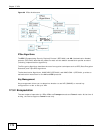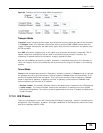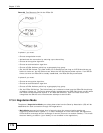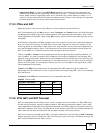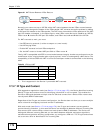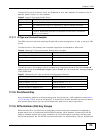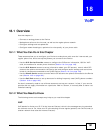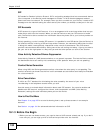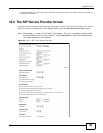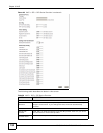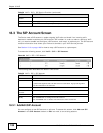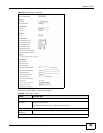
Chapter 18 VoIP
FMG3024-D10A / FMG3025-D10A Series User’s Guide
182
SIP
SIP stands for Session Initiation Protocol. SIP is a signalling standard that lets one network device
(like a computer or the Device) send messages to another. In VoIP, these messages are about
phone calls over the network. For example, when you dial a number on your Device, it sends a SIP
message over the network asking the other device (the number you dialed) to take part in the call.
SIP Accounts
A SIP account is a type of VoIP account. It is an arrangement with a service provider that lets you
make phone calls over the Internet. When you set the Device to use your SIP account to make
calls, the Device is able to send all the information about the phone call to your service provider on
the Internet.
Strictly speaking, you don’t need a SIP account. It is possible for one SIP device (like the Device) to
call another without involving a SIP service provider. However, the networking difficulties involved
in doing this make it tremendously impractical under normal circumstances. Your SIP account
provider removes these difficulties by taking care of the call routing and setup - figuring out how to
get your call to the right place in a way that you and the other person can talk to one another.
Voice Activity Detection/Silence Suppression
Voice Activity Detection (VAD) detects whether or not speech is present. This lets the Device reduce
the bandwidth that a call uses by not transmitting “silent packets” when you are not speaking.
Comfort Noise Generation
When using VAD, the Device generates comfort noise when the other party is not speaking. The
comfort noise lets you know that the line is still connected as total silence could easily be mistaken
for a lost connection.
Echo Cancellation
G.168 is an ITU-T standard for eliminating the echo caused by the sound of your voice
reverberating in the telephone receiver while you talk.
Use this screen to maintain basic information about each SIP account. You can also enable and
disable each SIP account, configure the volume, echo cancellation and VAD (Voice Activity
Detection) settings for each individual phone port on the Device.
How to Find Out More
See Chapter 3 on page 25 for a tutorial showing how to set up these screens in an example
scenario.
See Section on page 194 for advanced technical information on SIP.
18.1.3 Before You Begin
• Before you can use these screens, you need to have a VoIP account already set up. If you don’t
have one yet, you can sign up with a VoIP service provider over the Internet.



